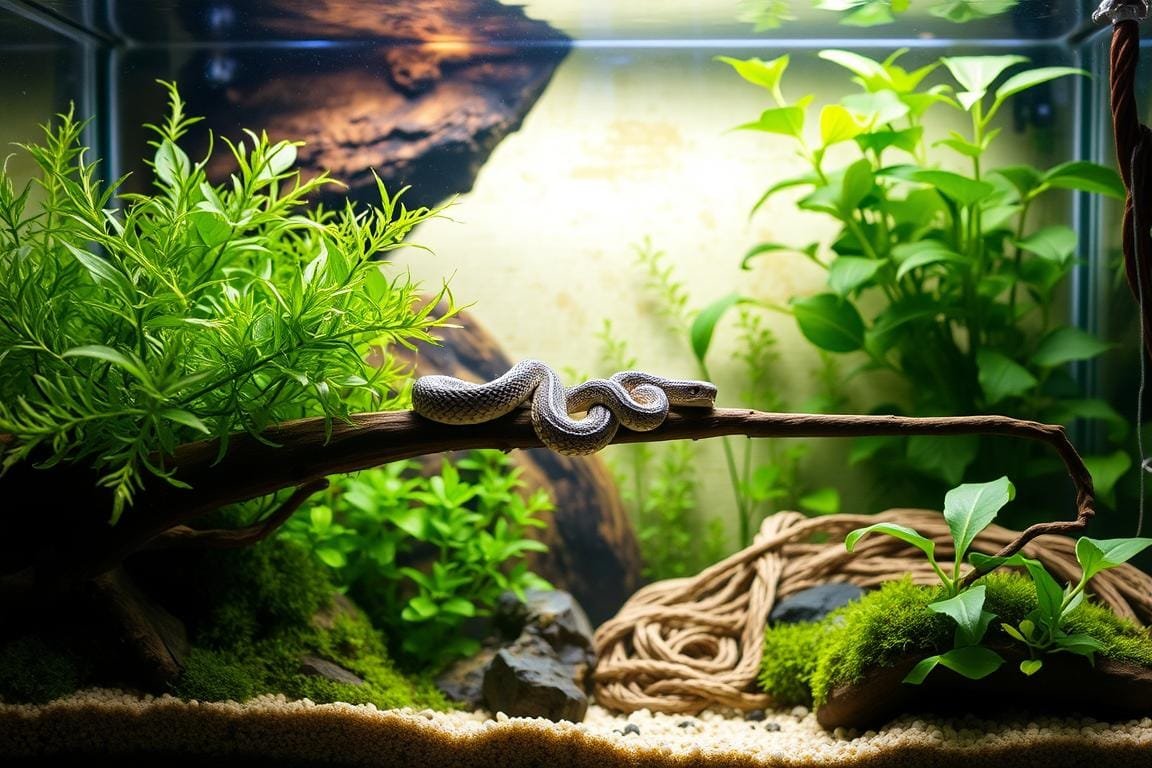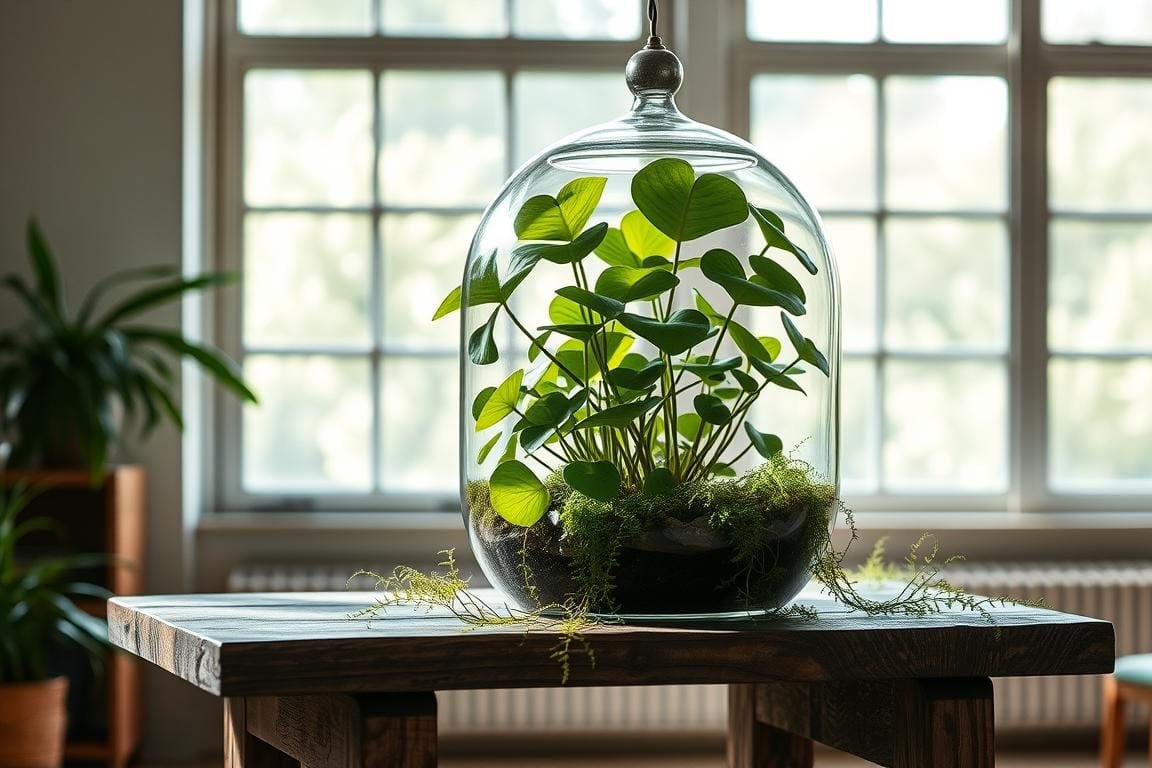With their jewel-toned scales and energetic personalities, these vibrant lizards have become popular pets for reptile enthusiasts. Native to Southeast Asia’s rainforests, they thrive in vertically oriented habitats that mimic their natural arboreal lifestyle. Proper husbandry ensures these active climbers stay healthy and display their full range of curious behaviors.
Adults typically reach 8–10 inches long, sporting bright green hues accented by speckled legs. Their tropical origins mean enclosures must maintain daytime temperatures of 75–85°F with humidity spikes above 70%. A bioactive terrarium setup not only supports their needs but also creates a self-cleaning ecosystem. This guide draws from trusted sources like ReptiFiles to outline lighting, substrate, and spatial requirements.
Key factors include UVB lighting for calcium metabolism and climbing branches for exercise. We’ll explore how to balance heat gradients, moisture levels, and enrichment elements to prevent stress-related issues. Whether you’re a first-time owner or refining your approach, these insights will help you build a habitat where your pet can flourish.
Understanding the Emerald Tree Skink’s Unique Needs
Originating from Southeast Asia’s lush rainforests, these diurnal reptiles thrive when their captive habitat mirrors their wild environment. Spending 80% of their day climbing vertical surfaces, they require specialized setups to support their active lifestyle.
Natural Habitat and Daily Patterns
In tropical forests, humidity levels rarely drop below 70%, creating ideal conditions for hydration and shedding. Morning sunlight filters through canopy gaps, providing natural UVB exposure that aids calcium absorption. This explains why captive environments need:
| Habitat Feature | Wild Equivalent | Captive Requirement |
|---|---|---|
| Vertical Space | Tree Trunks | 18″+ Tall Enclosure |
| Light Cycle | 12-Hour Daylight | UVB + Basking Lamp |
| Moisture | Rainforest Floor | 70-80% Humidity |
Space Requirements by Group Size
Social dynamics impact spatial needs. A single adult requires at least 18″x18″x24″ of climbing space. Groups need 30% more room to prevent territorial stress. Proper airflow prevents stagnant moisture while maintaining tropical conditions.
Key health benefits emerge when replicating native elements. Consistent UVB exposure strengthens immune function, while elevated humidity aids digestion. Observing natural behaviors like branch-hopping confirms your setup meets their needs.
Designing the Ultimate Emerald Tree Skink Enclosure

Creating a thriving vertical environment requires balancing space, materials, and natural elements. Let’s break down the essentials for crafting a home that keeps your pet healthy and engaged.
Recommended Terrarium Dimensions and Layout
Aim for a 24″L x 18″W x 36″H enclosure to provide climbing room. Front-opening designs like the Repti Zoo Glass Terrarium simplify access while maintaining humidity. Position branches diagonally across the height, leaving open areas for jumping.
Selecting Materials for Front-Opening and Well-Ventilated Enclosures
Choose glass or PVC for durability and insulation. Mesh tops paired with side vents create airflow without drying out the space. This setup prevents mold while supporting tropical plants like pothos or bromeliads.
Include a basking zone 6-8″ below the heat lamp. Use flat stones or driftwood to create temperature gradients. Live foliage offers hiding spots and helps maintain moisture levels – crucial for shedding and hydration.
For bioactive setups, consider a layered substrate with coconut fiber and sphagnum moss. This supports plant roots and beneficial microbes, reducing cleanup between feedings. Always secure lighting fixtures outside the terrarium to prevent burns.
Optimizing Lighting, Temperature, and Humidity

Creating the perfect environment for your scaly friend starts with mastering three key elements. Let’s dive into practical ways to balance these factors for a healthy, active pet.
Sunlight Made Simple
Replicating natural daylight cycles keeps your lizard thriving. Use a UVB bulb like the Arcadia ShadeDweller, positioned 8-12 inches above basking spots. Pair it with bright LED or fluorescent lighting for 12-hour daytime periods. At night, switch to moonlight bulbs or turn lights off completely.
Heat Zones for Comfort
Install a basking area heated to 95°F using halogen bulbs or ceramic heat emitters. Keep cooler zones at 75-80°F so your reptile can regulate its temperature. Place flat stones or wide branches under heat sources – these surfaces retain warmth effectively.
Humidity Hacks
Daily misting and live plants help maintain 70-80% humidity. Use digital probes in multiple spots to monitor levels accurately. Here’s a quick guide to humidity management tools:
| Tool | Purpose | Best Placement |
|---|---|---|
| Misting System | Raises moisture fast | Above plant clusters |
| Sphagnum Moss | Slow humidity release | Substrate layer |
| Hybrid Thermometer | Tracks temp/humidity | Near basking zone |
For bioactive setups, check our bioactive terrarium guide to automate humidity control. Remember: proper lighting and heat placement encourage natural behaviors like climbing and sunbathing!
Substrate, Enrichment, and Feeding Advice for a Thriving Emerald Tree Skink
Building a habitat that supports both physical and mental well-being starts with smart material choices and engaging activities. Let’s explore how to create a dynamic environment that keeps your Lamprolepis smaragdina active and healthy.
Choosing the Right Substrate and Maintenance Tips
A 3-inch layer of coconut fiber mixed with sphagnum moss works best. This combo holds moisture for humidity while cushioning jumps. Replace 25% monthly to prevent bacteria buildup.
- Spot-clean waste daily using a probe to check dampness levels
- Full substrate changes every 4-6 months maintain enclosure health
- Add leaf litter for natural decomposition and microbe support
Incorporating Natural Elements and Enrichment Decor
Rotate cork rounds and magnolia branches weekly to spark exploration. Live plants like pothos provide hiding spots and air purification. Use vertical vines to encourage climbing – their favorite workout!
Diverse Feeding Options and Proper Supplementation
Offer gut-loaded crickets and dubia roaches dusted with Repashy Calcium Plus LoD. Adults eat 5-7 insects every other day during daylight hours. Juveniles need daily meals for growth.
Always purchase feeders from reputable sources to avoid parasites. A varied diet prevents nutritional gaps – try adding occasional waxworms as treats. Monitor appetite changes with a digital probe to track activity patterns.
Wrapping Up Your Emerald Tree Skink Enclosure Journey
Caring for these vibrant reptiles becomes rewarding when their habitat mirrors nature’s blueprint. By combining vertical space, precise lighting, and tropical humidity, you create a home where natural behaviors flourish.
Remember three essentials: UVB bulbs support bone health, layered substrates maintain moisture, and varied diets with dubia roaches prevent nutritional gaps. Rotate climbing branches and feeder insects to keep meals and activities engaging.
Trusted sources like ReptiFiles simplify troubleshooting – bookmark their care sheets for quick reference. Temperature gradients and live plants aren’t just decorative; they’re vital for your pet’s physical and mental wellness.
Ready for next steps? Explore The Bio Dude’s bioactive guides to automate humidity control. With thoughtful setup and quality feeders, your scaled companion will thrive for years. Happy habitat building!





